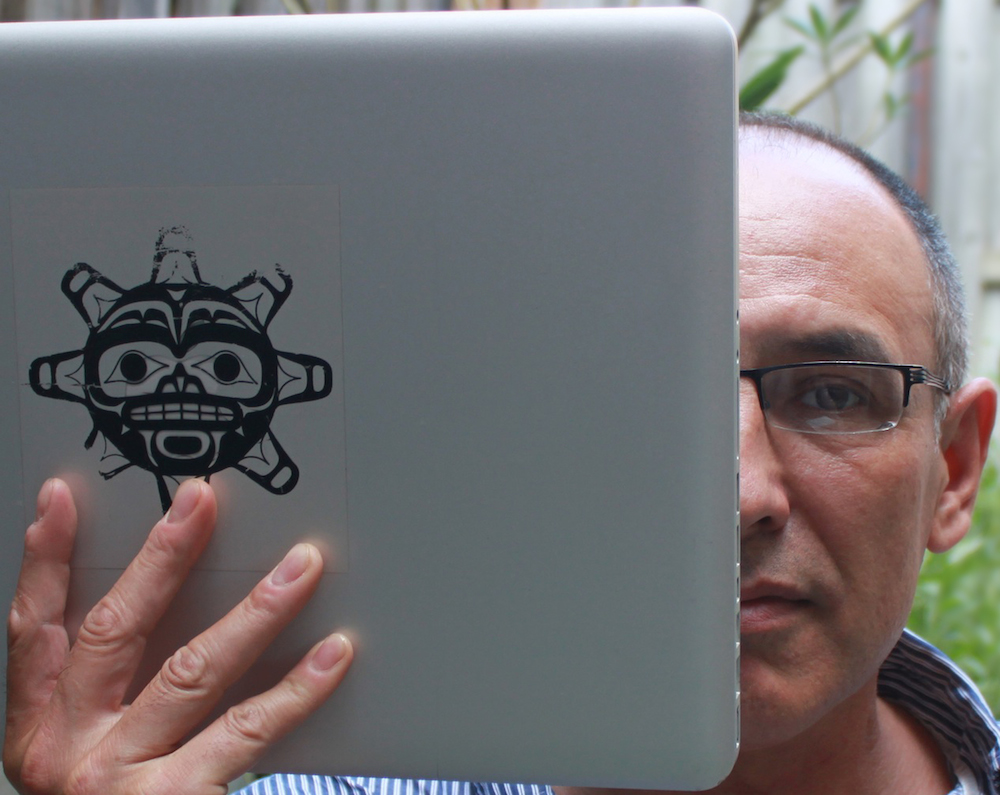
Archer Pechawis, “still life with laptop, 2012”. Photo by Adam Steel.
Re: “We Lost an Entire Generation,” Fall 2017 issue.
To the Editors of Canadian Art,
I am not dead.
The declaration of my death in the Fall 2017 issue was my first mention, that I’m aware of, in Canadian Art, and while I am honoured to be featured in any article alongside the late René Highway, Âhasiw Maskêgon-Iskwêw, and Terry Haines, I was appalled by the poor oversight and lack of awareness of our Indigenous arts community. I am referring here to two problematic aspects of the article: my being reported as deceased in two different sections of the magazine, and having Paul Lang’s artwork BigRedDice misattributed to me.
As to being dead, I have been a practicing artist since 1984, and while I haven’t been terribly prolific in the last few years, I am still here, and still making work. This past March, I was commissioned by Flux Media Art Gallery in Victoria to create a new performance piece on the theme of personal, historical, and cultural traumas. I have a prominent online presence, which includes an artist website, a professional website, a Facebook profile, a LinkedIn profile, and a page on my distributor, Vtape’s, website. I am really, really, easy to find. A phone call would have cleared up any confusion.
I appreciate that Canadian Art reached out to me, via email, September 12th, but this mistake was first tweeted about by Canadian Art on September 6th. I would have preferred it if someone from the magazine had contacted me immediately. These things are personal, and should be responded to as such.
My brother, Maxwell Harvey Mayling, went missing last November. The RCMP have classified his disappearance as a suspected homicide, but his body has not been found. This made it especially distressing for myself and my family to be falsely declared dead. I did not wish to discuss my brother’s disappearance in this letter, but it links my family to the larger community, and the larger issues we live with, in a terrible and relevant way: like us, so many Indigenous families have lost loved ones to violence, or have otherwise had their lives irrevocably altered by colonial violence in its myriad forms. This, more than anything, underscores the need for rigour and sensitivity when researching and writing about our artists and their place in community. We have had enough conflict and trauma in our lives and our history. My family, and I personally, have definitely had enough.
As I mentioned earlier, the artwork attributed to me in this article, BigRedDice, is not mine, it is Métis artist Paul Lang’s. I created the online version of his piece; in the credits section, Paul is listed as “Concept, big red dice creator, video maker, conceptual terrorism, general troublemaking,” and my credits are, “Flash Authoring, Webmeister, conceptual mechanic, actionscript code monkey.” Article author Lindsay Nixon did attempt to contact me before publication, but couldn’t reach me. She has apologized since in a way that was personal and meaningful to me.
It has been an incredible honour to be a part of the Indigenous arts community/movement over the last 35 years. I have had the opportunity to meet, work with, and learn from the giants who blazed the trail for us against seemingly impossible odds, combatting racism, incomprehension, and indifference to make a space for us in the larger Canadian art milieu. I have had the intense satisfaction of watching my peers achieve the some of highest levels of recognition and success, and perhaps most gratifyingly have watched new cohorts of smart young Indigenous artists pick up where we have left off. Given this history as an Indigenous artist, it is especially disturbing to be erased by a mainstream (read non- Indigenous) publication that is the “preeminent platform for journalism and criticism about art and culture in Canada.”
In future I would ask all of you to be more careful. This is our history. Many established Indigenous artists have very little writing about their early work. There is even less mainstream acknowledgement of the artists who were working on the fringes of the art world in those early days. We need rigorous writing to make sure that our art history, our work and the politics of those times survives. We need publications such as Canadian Art to understand the context within which the art was created and how that very important work prepared the ground for where we are now and how it informs the current cultural and political conversations. It is my sincere hope that some learning can happen from this situation, more attention can be paid to Indigenous artists, and these mistakes can be prevented in the future.
I appreciate Canadian Art reaching out, but I feel that as a respected, mainstream publication, this was a huge error that should never have happened. It had an impact on my family, on me personally, and as an artist. I feel unresolved, but perhaps this is the beginning of a deeper and more meaningful conversation. These things matter.
On a personal note, please be careful with our community. We have a lot going on.
Archer Pechawis